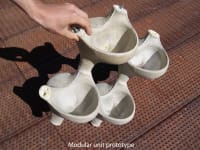The average distance fresh food travels before being purchased and consumed in the US is over 1,000 miles. This huge distance creates numerous problems, including increased emissions due to transportation, spoilage of goods, and reduced product quality. Perhaps more unnerving is the disconnection we have with food. This disconnect in the food cycle creates a dangerous environmental feedback loop and puts healthy ecosystems at risk. What is needed is a reconnection of food growth with everyday life.
The hydroponic screen wall (HSW) system attempts to reunite food growth and human interaction. The HSW is an interior garden wall, which is composed of interconnected, self-contained modular units. Each modular unit is a single cast piece, which contains the tubes and water reservoirs needed to grow a single plant hydroponically. Potential benefits of the HSW system include a reduction in the consumption of both fossil fuel and material resources relative to the transportation, packaging, and preservation of food crops. By emphasizing hydroponics and controlled environment agriculture as the principle means of cultivation as compared with traditional soil-based agriculture, the potential benefits are further extended to include the more efficient use of water, along with the reduction or elimination of pesticides, herbicides, and fertilizers that are often associated with ecosystem damage and destruction.
The HSW is unique amongst consumer hydroponics systems because of the modular design and the goal to be integrated into the architecture of a building. This integration facilitates a more conscious and ecological lifestyle, while blurring the lines between the occupants and the exterior natural environment.
The HSW system could be applied to a number of applications, ranging from personal home systems to larger scale, architecturally significant installations. Installation in a large building could provide significant food growing potential, radically changing our interactions with food growth and positively effecting the community.
Hydroponic farming represents over a $500M market size, with almost 8% growth in 2011. This growing industry is ready for a new system that merges community interaction and food growth.
The HSW manufacturing is ideally suited for mass production. Manufacturing would be performed using compression molding to create each modular wall unit. Sustainable materials that are safe for hydroponic use would be used to create each modular unit. This manufacturing method could enable cost effective, scalable production of hydroponic units.
The HSW system is a unique modular hydroponic system that closes the gap between food production and local consumption. By developing a modular system, needs of various communities can be met without substantial system redesigns and costs can be kept very low.
Like this entry?
-
About the Entrant
- Name:Gabriel Birch
- Type of entry:teamTeam members:Matthew Williams
- Patent status:none








